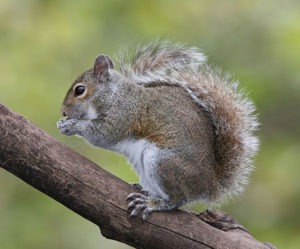Of the three species of squirrels that can be found in Kentucky, the gray squirrel (Sciurus carolinensis) is the most common. Gray squirrels are native to most of the eastern U.S. They have also been introduced to parts of the western U.S. and several European countries. In locations where gray squirrels have been introduced, they tend to cause significant ecological damage and will often outcompete native squirrel species.
Gray squirrels naturally live in mature forests; however, they are very adaptable and commonly live in urban and suburban settings. Gray squirrels build two different types of homes – leaf nests and cavity nests. Leaf nests are the nests that they construct out of leaves and twigs in the branches of trees. They are easy to see at this time of year because they aren’t hidden by tree leaves. Leaf nests can sometimes be fairly large and are roughly dome shaped with a hollow space in the middle for the squirrel to curl up in.

Typically, the nests they construct in cavities are in hollow tree trunks and branches. However, in more urban and suburban areas, those hollow areas could be in attics or behind the siding of a house. That’s one reason why it is so important to make sure that any holes in your siding, soffits, attic, etc. are repaired quickly so a squirrel or other critter doesn’t move in. Squirrels will stuff their cavity nests with leaves and dried grass for insulation.
A single gray squirrel may maintain two or more homes that it rotates through at various times throughout the season. Gray squirrels typically nest alone, except in the case of a mother with young or during the coldest part of the winter when several may share a nest, presumably for the extra warmth. Gray squirrels do not hibernate and are active all year long, although they may not come out of their nests on frigid winter days.
Gray squirrels mate twice a year in the late winter and in the summer. The female is pregnant for 40-45 days, with babies typically being born in February/March or June /July. Each litter can have between one and eight babies. Like many other mammals, baby squirrels are born naked and with their eyes closed. The mother is solely responsible for the care of her young. By around eight weeks old, the baby squirrels are weaned and can be on their own a few weeks later.
Despite their name, gray squirrels are not always gray. In some areas, they can have quite a bit of red fur mixed in with the gray. However, they will still have a white belly which is an easy way to distinguish them from the closely related fox squirrels (Sciurus niger). Gray squirrels can also be almost solid black or almost solid white. Not all white squirrels are albino either. Some are leucistic, which means they have a partial loss of pigmentation. Leucistic animals will have dark eyes, while albinos will have pink eyes. Black grey squirrels and white grey squirrels are most common in and around cities where they don’t have the same predation pressures as squirrels in wilder settings. Some locations, such as Western Kentucky University, have become known for their populations of white (or black) squirrels.
Gray squirrel diets are highly variable and commonly include nuts, seeds, fruits, and buds. They will also gnaw on bones and antlers as a supply for calcium and other minerals. In addition, they are notorious for emptying bird feeders and people often go to great lengths to try to “squirrel-proof” their feeders. They will also cache food for later by digging a hole in the ground and burying a nut. Most of the nuts they bury go unused and many will sprout. Gray squirrels, therefore, can be thought of as miniature “Johnny Appleseeds” for many forest trees.
Anyone who has ever watched gray squirrels playing in their yard or in the forest, knows that they can be quite vocal animals. Gray squirrels make a variety of sounds from loud chatters when they are agitated to soft purrs during the mating season. They also use their bushy tail as an important form of non-verbal communication. The rate at which it rapidly twitches or slowly draws large circles with its tail can tell a lot about the squirrel’s temperament.
It can be quite fun to watch all of the different behaviors and listen to their different vocalizations as they interact with each other and the environment around them. I highly encourage you to stop and take time do just that the next time you find a squirrel. You might just find a new appreciation or re-ignite an old appreciation for these interesting and important members of the Kentucky ecosystem.

This article was part of Shannon’s original Kentucky Pollinators and Backyard Wildlife blog which evolved into the blog for Backyard Ecology.

Backyard Ecology: Exploring Nature in Your Backyard
Nature isn’t just “out there.” It’s all around us, including right outside our doors. Hi, my name is Shannon Trimboli, and I am the host of Backyard Ecology. I live in southcentral Kentucky and am a wildlife biologist, educator, author, beekeeper, and owner of a nursery specializing in plants for pollinators and wildlife conservation. I invite you to join me as we ignite our curiosity and natural wonder, explore our yards and communities, and improve our local pollinator and wildlife habitat. Learn more or subscribe to my email list at www.backyardecology.net.

Leave a Reply